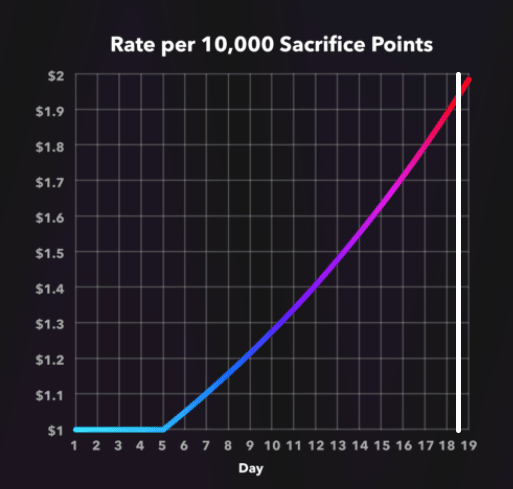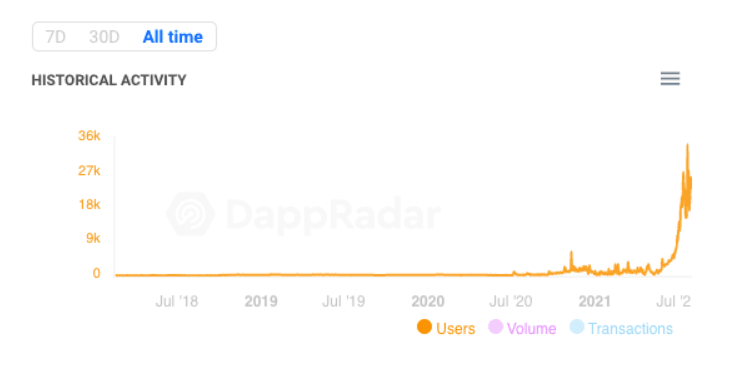Can PulseChain bring dapps suffering high fees back from the brink
PulseChain is a new blockchain-based cryptocurrency ecosystem that claims to offer significant enhancements over Ethereum. Moreover, the launch of the PulseChain platform is claimed to be the largest airdrop, or initial distribution, in the history of blockchain. DappRadar investigates.
To be clear from the start, PulseChain is the network while Pulse (PLS is the proposed ticker) is the native coin of the PulseChain system. The PulseChain project is led by Richard Heart, who was also involved in the HEX project. In essence, PulseChain is an Ethereum hard-fork with a snapshot of the entire Ethereum blockchain converted into a Proof-of-Stake blockchain. With faster transaction times and lower fees.
See your tokens, NFTs and DeFi positions across different blockchains, all in one place. Connect your Web3 wallet and check out your portfolio!
The PulseChain team has highlighted several features that it says will set the project apart from Ethereum. Namely that it will be more energy-efficient, faster, and cheaper than Ethereum. It’s worth noting, however, that Ethereum is undergoing an upgrade that could resolve some of its current energy concerns. Ethereum’s ETH token has no maximum supply cap, which creates the risk of inflation for holders. PulseChain’s official cryptocurrency is PLS and is designed as a deflationary asset. Eliminating PLS inflation risk with a token burn mechanism. Furthermore, validators will only earn fees and 25% of the fees will be burnt to reduce circulating supply. Again, it is vital to mention that Ethereum’s own EIP1559 will enact a burn mechanism similar to that proposed on PulseChain.
Moreover, PulseChain has stated that it also wants to decrease the burden on the Ethereum network and has no intention to kill or directly compete with it. Furthermore, it appears the chain was first conceived to allow HEX holders to make transactions whilst avoiding Ethereum gas fees.
At the time of writing the PulseChain network is in testing and expected to launch imminently, although a launch date hasn’t been confirmed. Interestingly, before the launch, a 30-day sacrifice period was set up, giving investors a chance to convert some of their crypto assets, such as ETH, and HEX to PLS once it goes live.
Ethereum Hard-Fork
As mentioned above PulseChain will be a hard-fork of the Ethereum blockchain. As such it will replicate all the ERC-20 tokens that exist over to PulseChain. Users will effectively receive a copy of all their current assets on PulseChain and even those not investing in PulseChain can receive these tokens. Importantly, PulseChain’s native token and all the coins on it are designed to start with no value so as not to benefit from the hard work of others.
Not only is it being copied but it is being improved upon to become a delegated Proof-of-Stake blockchain like Binance Smart Chain or EOS. Running with a set of validators, therefore, means users will avoid high gas fees when making transactions on PulseChain. This model enables optimization that will reduce block times to around 3 seconds. Which compared to Ethereums current 13, is a 4x improvement. In layman’s terms, PulseChain could be described as a Binance Smart Chain-style blockchain. Giving users full compatibility with Ethereum plus the snapshot of the Ethereum blockchain. Importantly BSC and Polygon are not forks of the Ethereum blockchain but forks of the source code. PulseChain is a direct copy and in this way is more like Bitcoin Cash, a copy of the entire chain.
Make the Sacrifice
There are several ways to get tokens on PulseChain. Firstly you can get a copy of the assets you already own on Ethereum through a free airdrop mechanism that will become live when PulseChain does. Another unique mechanism that has been labeled the ‘sacrifice period’ invites users to sacrifice, or effectively burn tokens they already own, such as ETH. That will then be replaced by PLS at a greater amount once it launches. For example, sacrificing 1 ETH will get you 7000 PLS upon launch.

Earlier and larger sacrifices receive more points. With the rate remaining the same throughout the first five days of the sacrifice period and then increasing by 5% in the final 14 days. Sacrificing ended on the 2nd of August 2021. The total sacrifice points for each sacrificer’s address’s points (at the same metamask address) are added up across all the supported chains and the SENS.org report. This creates a list of sacrificers ranked by total points from largest to smallest.
One unique feature enacted during the sacrifice period has been to allow investors to sacrifice their stake to charity rather than to PulseChain directly. Importantly, still receiving a portion of PLS for the stake. The team raised $25,000,000 for SENS.org medical research in just 6 days. Importantly, sacrifices to SENS.org during the sacrifice phase earned 25% fewer points compared to sacrifices at Pulse.info.
Sacrifices Raise Suspicion
The sacrificed amount seemingly goes directly to Richard Heart. All except the sacrifices made to the SENS organization. Interestingly, it’s called a sacrifice for a coin that will launch at zero value in order that it will not profit from the work of others. Along with it not being a taxable event to revive the coins, unlike other normal airdrops. Then you will probably get a share of the total supply of PLS coins. There was much skepticism around the HEX project when it launched, but it’s safe to say it has withstood the test of time and come out looking like a rather good product.
Dapps Revitalized
A key factor that will underline the future success of PulseChain and most interesting to DappRadar will be its ability to take decentralized applications (dapps) currently suffering from fees on Ethereum and revive them.
Blockchain games and DeFi applications running on Ethereum have traditionally suffered due to high gas fees. Hence the explosion of activity on alternative chains like BSC and Polygon where fees and transaction times are greatly reduced. Due to the fact that PulseChain will have a copy of Ethereum assets and smart contracts dapp developers could simply try and relaunch on PulseChain.
For example, a blockchain game running on Ethereum that has lost its user base due to high gas fees could relaunch very easily on PulseChain. Offering its users faster and cheaper actions which could effectively revive the dapp and its activity. The same story is true for a DeFi exchange such as Uniswap. Same service plus lower fees and faster transactions. Interestingly, this revitalization process has been observed in the flesh during 2021. With dapp games such as Axie Infinity leaving Ethereum in favor of its custom-built Ronin sidechain, or Aavegotchi moving to Polygon. On these alternative chains, they could offer users reduced fees and faster transactions. In turn, generating all-time high usage.


In summary
It will be interesting to see the reaction from the dapp developer community once PulseChain officially goes live. Perhaps more interesting will be any marketing efforts from the team to attract developers to port over. Or if they will execute any at all. It is yet to be seen if PulseChain is merely a vessel for HEX token holders to conduct business or an attempt at a fully-fledged blockchain solution aiming to attract a vibrant ecosystem of dapps. Either way, the project presents some very interesting staking opportunities for those looking at long-term investments and arguably for those that took the leap of faith by investing in the HEX project.
The above does not constitute investment advice. The information given here is purely for informational purposes only. Please exercise due diligence and do your research. The writer holds positions in ETH, BTC, ADA, NIOX, AGIX, MANA, SAFEMOON, SDAO, CAKE, HEX, LINK, GRT, CRO, SHIBA INU, AND OCEAN.
.mailchimp_widget {
text-align: center;
margin: 30px auto !important;
display: flex;
border-radius: 10px;
overflow: hidden;
flex-wrap: wrap;
}
.mailchimp_widget__visual img {
max-width: 100%;
height: 70px;
filter: drop-shadow(3px 5px 10px rgba(0, 0, 0, 0.5));
}
.mailchimp_widget__visual {
background: #006cff;
flex: 1 1 0;
padding: 20px;
align-items: center;
justify-content: center;
display: flex;
flex-direction: column;
color: #fff;
}
.mailchimp_widget__content {
padding: 20px;
flex: 3 1 0;
background: #f7f7f7;
text-align: center;
}
.mailchimp_widget__content label {
font-size: 24px;
}
.mailchimp_widget__content input[type=”text”],
.mailchimp_widget__content input[type=”email”] {
padding: 0;
padding-left: 10px;
border-radius: 5px;
box-shadow: none;
border: 1px solid #ccc;
line-height: 24px;
height: 30px;
font-size: 16px;
margin-bottom: 10px !important;
margin-top: 10px !important;
}
.mailchimp_widget__content input[type=”submit”] {
padding: 0 !important;
font-size: 16px;
line-height: 24px;
height: 30px;
margin-left: 10px !important;
border-radius: 5px;
border: none;
background: #006cff;
color: #fff;
cursor: pointer;
transition: all 0.2s;
margin-bottom: 10px !important;
margin-top: 10px !important;
}
.mailchimp_widget__content input[type=”submit”]:hover {
box-shadow: 2px 2px 5px rgba(0, 0, 0, 0.2);
background: #045fdb;
}
.mailchimp_widget__inputs {
display: flex;
justify-content: center;
align-items: center;
}
@media screen and (max-width: 768px) {
.mailchimp_widget {
flex-direction: column;
}
.mailchimp_widget__visual {
flex-direction: row;
justify-content: center;
align-items: center;
padding: 10px;
}
.mailchimp_widget__visual img {
height: 30px;
margin-right: 10px;
}
.mailchimp_widget__content label {
font-size: 20px;
}
.mailchimp_widget__inputs {
flex-direction: column;
}
.mailchimp_widget__content input[type=”submit”] {
margin-left: 0 !important;
margin-top: 0 !important;
}
}
- Bitcoin
- blockchain
- blockchain compliance
- blockchain conference
- coinbase
- coingenius
- Consensus
- crypto conference
- crypto mining
- cryptocurrency
- DappRadar
- decentralized
- DeFi
- Digital Assets
- ethereum
- machine learning
- non fungible token
- plato
- plato ai
- Plato Data Intelligence
- PlatoData
- platogaming
- Polygon
- proof of stake
- W3
- zephyrnet











